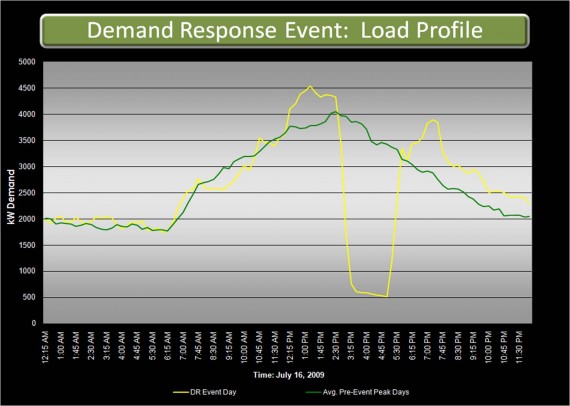When It's A Scorcher Outside, Flex Your Power
It is summer, when temperatures soar to over 90 degrees and the phrase “rolling brown-outs” becomes all too common. Brown-outs come from power shortages when we’re all trying to beat-the-heat by running our air conditioners. Businesses and homes operate off the same power grid – so we can all play a role in avoiding brown-outs. In some cases by delaying energy use until late in the day you can even save come big dollars on your electricity bill
The power grid is a complex web of power plants and transmission lines designed to meet our average peak demand for electricity. When it gets too hot outside demand spikes and there isn’t enough electricity to go around. There are two things we can do: get more electricity from somewhere or curtail our energy use.
When the power grid is running low utility companies have a couple of options. They can buy power from outside their region, which basically means paying to have electrons pumped in from far away. The problem with that approach is prices skyrocket and we wind up paying for it later. Anyone remember a little company named Enron? It was famous for messing with everyone’s electrons.
Another strategy is to fire-up old power plants or pay for companies with generators to turn them on. These plants and generators are old and out of use for a reason; generally they rely on very dirty fuel sources like coal, oil or diesel – not very environmentally friendly. Oh, don’t forget the utility has to pay a small fortune for those electrons too, which we wind up paying for in the long run.
Demand Response
Companies like Kendall-Jackson have been doing our part to eliminate brown-outs through voluntary demand response programs. Essentially, when the utility realizes it’s going to be too hot and there won’t be enough electricity to go around they alert us to get ready to cut our power usage.
They ask us to shut down in the afternoon. That’s the time when businesses are still in production, offices are still running with all the lights on, and people are arriving home — turning up the air conditioner, doing a load laundry and turning on the stove.
In the summer time our biggest energy demand is for refrigeration of wine tanks and air conditioning for barrel cellars. When we get the call from the utility we prepare to stop work, seal everything up tight and shut down our wineries. We close all the doors and turn off the lights, refrigeration and air conditioning and wait it out until around 6:00 pm when it’s all clear.
It’s pretty amazing; even when it is 100 degrees outside our wine won’t change temperature more than 1-2 degrees over a six hour period, and that’s with everything shut off. The insulation in the barrels and tanks ensures the thermal mass stored in liquid doesn’t get too hot. All in all, we curtail 3,275 kilowatts, which is equal to 650 homes shutting completely down.
Demand Response At Home
More and more utilities are installing “smart meters” for home electricity use. Smart meters upload real-time data to the utility, letting the company know how much electricity your using and when. This way they can charge you more during peak demand periods. It’s their way of “encouraging” consumers to wait until after 6:00 pm to get busy at home. Here are some ways you can both help out the power grid and save electricity costs, whether or not you’re on a smart meter:
- Moderate the temperature setting of your air conditioner, especially while you’re away from home. Every 1 degree difference is equal to about 5% of your total electricity use.
- Wait to do the laundry until later in the evening. It will cut down the appliance’s electricity usage and reduce the amount of AC you need to counter act the dryer.
- Don’t use the stove or oven. Throw on a pair of shorts and get busy grilling.
- If you planned to go out to dinner or do some shopping at the mall – go on a hot night. They’ll have to have the AC on no matter what, so you might as well turn your home AC down and head out.
- Looking to upgrade that old thermostat? For under $100 at The Home Depot you can buy a wi-fi enabled unit you can monitor and adjust from the web or your iPhone.





